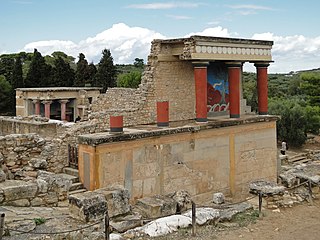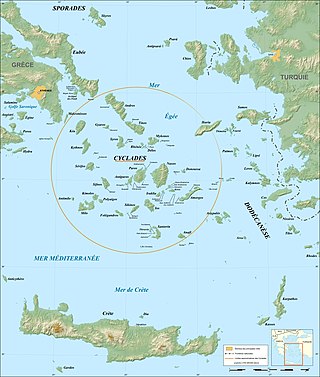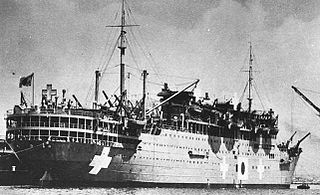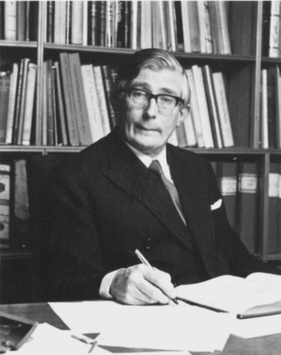
Linear B is a syllabic script that was used for writing in Mycenaean Greek, the earliest attested form of the Greek language. The script predates the Greek alphabet by several centuries, the earliest known examples dating to around 1400 BC. It is adapted from the earlier Linear A, an undeciphered script potentially used for writing the Minoan language, as is the later Cypriot syllabary, which also recorded Greek. Linear B, found mainly in the palace archives at Knossos, Kydonia, Pylos, Thebes and Mycenae, disappeared with the fall of Mycenaean civilization during the Late Bronze Age collapse. The succeeding period, known as the Greek Dark Ages, provides no evidence of the use of writing.

The Minoan civilization was a Bronze Age culture which was centered on the island of Crete. Known for its monumental architecture and its energetic art, it is often regarded as the first civilization in Europe.

Knossos is a Bronze Age archaeological site in Crete. The site was a major center of the Minoan civilization and is known for its association with the Greek myth of Theseus and the minotaur. It is located on the outskirts of Heraklion, and remains a popular tourist destination.

Cycladic culture was a Bronze Age culture found throughout the islands of the Cyclades in the Aegean Sea. In chronological terms, it is a relative dating system for artifacts which serves as a roughly contemporary dating system to Helladic chronology and Minoan chronology (Crete) during the same period of time.
Manfred Bietak is an Austrian archaeologist. He is professor emeritus of Egyptology at the University of Vienna, working as the principal investigator for an ERC Advanced Grant Project "The Hyksos Enigma" and editor-in-chief of the journal Ägypten und Levante and of four series of the Austrian Academy of Sciences, Institute of Oriental and European Archaeology (2016–2020).

The British School at Athens (BSA) is an institute for advanced research, one of the eight British International Research Institutes supported by the British Academy, that promotes the study of Greece in all its aspects. Under UK law it is a registered educational charity, which translates to a non-profit organisation in American and Greek law. It also is one of the 19 Foreign Archaeological Institutes defined by Hellenic Law No. 3028/2002, "On the Protection of Antiquities and Cultural Heritage in General," passed by the Greek Parliament in 2002. Under that law the 17 accredited foreign institutes may perform systematic excavation in Greece with the permission of the government.

Duncan Mackenzie was a Scottish archaeologist, whose work focused on one of the more spectacular 20th century archaeological finds, Crete's palace of Knossos, the proven centre of Minoan civilisation.

Alan John Bayard Wace was an English archaeologist, best known for his excavations at the Bronze Age site of Mycenae in Greece. He served as director of the British School at Athens (BSA) between 1914 and 1923, and excavated widely in Thessaly, in Laconia and in Egypt. He was also an authority on Greek textiles and a prolific collector of Greek embroidery.

MS Aramis was a Messageries Maritimes ocean liner that was launched in France in 1931. She was a sister ship of Félix Roussel and Georges Philippar. The three sisters were highly unusual in having square funnels. Aramis' interior was an Art Deco interpretation of Minoan design.

Arthur Alexander Johann Milchhöfer was a German archaeologist born in Schirwindt, East Prussia, Kingdom of Prussia. He specialized in studies of Greek Antiquity, and is remembered for his topographical research of ancient Attica.

Phylakopi, located at the northern coast of the island of Milos, is one of the most important Bronze Age settlements in the Aegean and especially in the Cyclades. The importance of Phylakopi is in its continuity throughout the Bronze Age and because of this, it is the type-site for the investigation of several chronological periods of the Aegean Bronze Age.

Martin Sinclair Frankland Hood,, generally known as Sinclair Hood, was a British archaeologist and academic. He was Director of the British School at Athens from 1954 to 1962, and led the excavations at Knossos from 1957 to 1961. He turned 100 in January 2017 and died in January 2021, two weeks short of his 104th birthday.
Leonard Robert Palmer was author and Professor of Comparative Philology at the University of Oxford from 1952 to 1971. He was also a Fellow of Worcester College, Oxford. Palmer made some significant contributions to the study of Classical languages, and in the area of historical linguistics.
Peter Michael Warren, is a British archaeologist and academic, specialising in the Aegean Bronze Age. From 1977 to 2001, he was Professor of Ancient History and Classical Archaeology at the University of Bristol, where he is currently Professor Emeritus and a senior research fellow at the university.
Edith Eccles was a British classical archaeologist who did work at the British School at Athens and worked with Sir Arthur Evans at Knossos on Crete in the 1930s. She studied at Royal Holloway, University of London.
Yannis Hamilakis is a Greek archaeologist and writer who is the Joukowsky Family Professor of Archaeology and Professor of Modern Greek Studies at Brown University. He specialises in archaeology of the prehistoric Aegean as well as historical archaeology, including ethnography and anthropology. His research interests include nationalism, postcolonialism, and migration studies.
Alexandre Farnoux is a French historian, a specialist on the Minoan civilisation and Delos.
Helen Hughes-Brock is an independent scholar working in the archaeology of the Minoan civilization of Crete and Mycenaean Greece.
Penelope Anne Mountjoy is an archaeologist from the United Kingdom who specializes in Mycenaean ceramics. Mountjoy has written several books and received numerous awards and fellowships to continue her research on Greek pottery.
Christine E. Morris is an Irish classical scholar, who is the Andrew A. David Professor in Greek Archaeology and History at Trinity College Dublin. An expert on religion in the Aegean Bronze Age, her work uses archaeological evidence to examine the practice and experience of belief. She is a member of the Standing Committee for Archaeology for the Royal Irish Academy.










